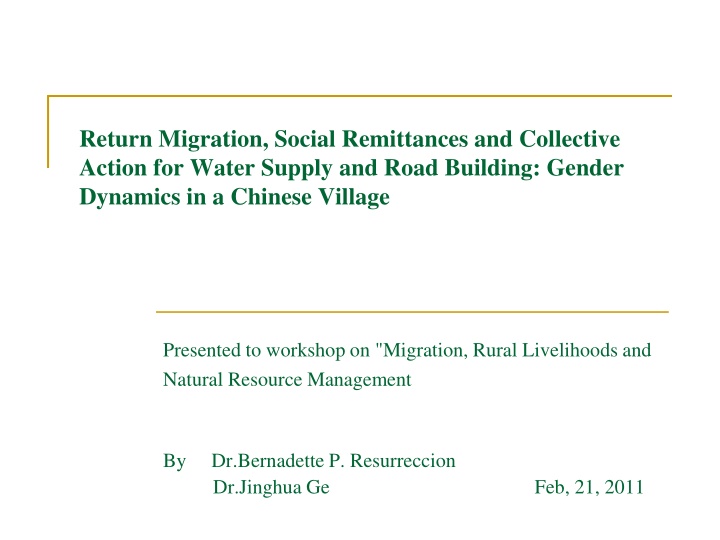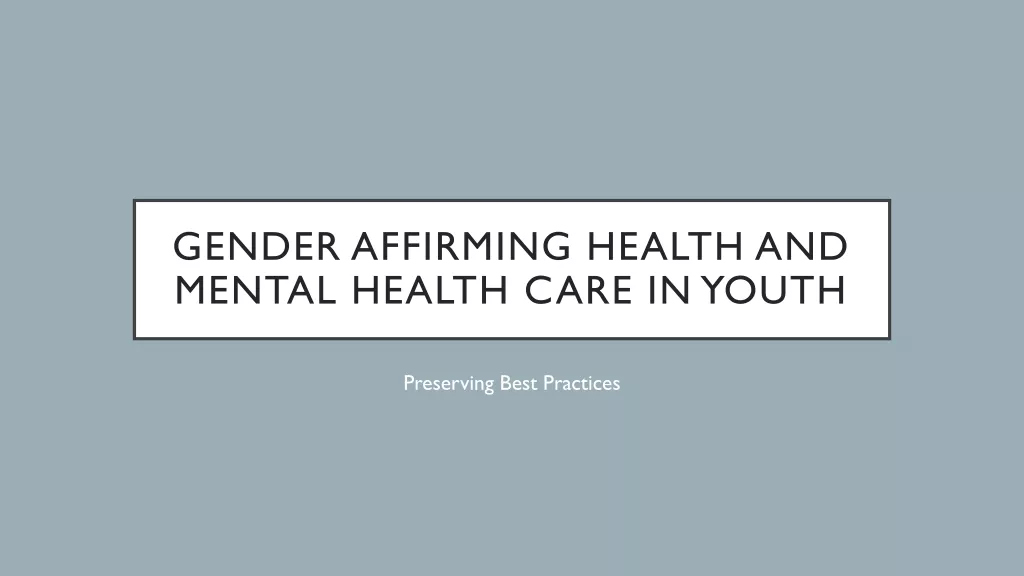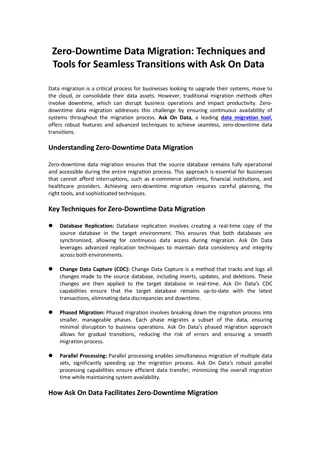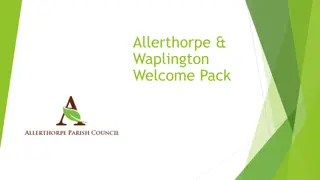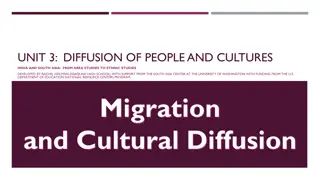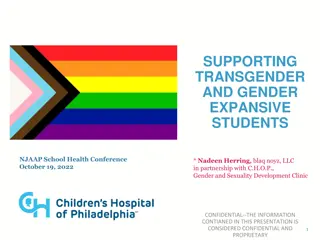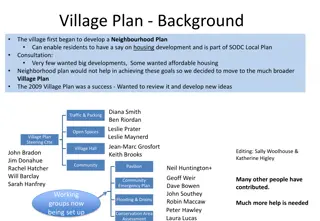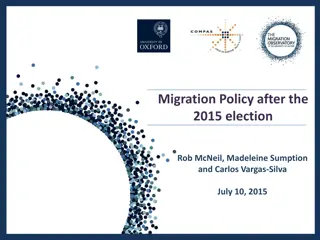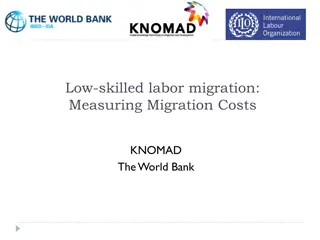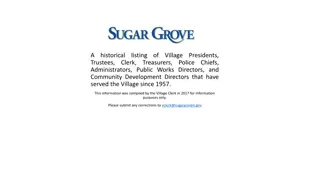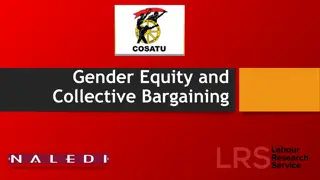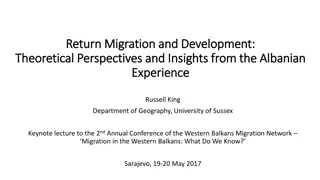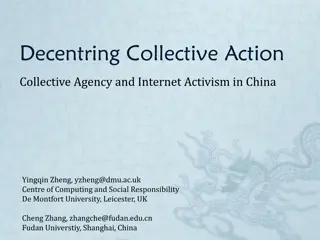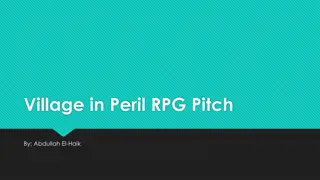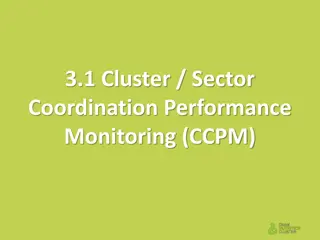Gender Dynamics in a Chinese Village: Return Migration and Collective Action
This study explores the gender dynamics in a Chinese village focusing on return migration, social remittances, and collective action for water supply and road building. It examines the impact of migration on livelihoods, natural resource management, and village infrastructure, shedding light on the roles of men and women in these processes.
Download Presentation

Please find below an Image/Link to download the presentation.
The content on the website is provided AS IS for your information and personal use only. It may not be sold, licensed, or shared on other websites without obtaining consent from the author.If you encounter any issues during the download, it is possible that the publisher has removed the file from their server.
You are allowed to download the files provided on this website for personal or commercial use, subject to the condition that they are used lawfully. All files are the property of their respective owners.
The content on the website is provided AS IS for your information and personal use only. It may not be sold, licensed, or shared on other websites without obtaining consent from the author.
E N D
Presentation Transcript
Return Migration, Social Remittances and Collective Action for Water Supply and Road Building: Gender Dynamics in a Chinese Village Presented to workshop on "Migration, Rural Livelihoods and Natural Resource Management By Dr.Bernadette P. Resurreccion Dr.Jinghua Ge Feb, 21, 2011
1. Background Litao village, Xintun Township In Wangmo County, Southwest Buyi and Miao Autonomous Prefecture in Guizhou Province 146 households, 688 population, 5 villager groups and 9 clans 124 out-migrants (81 male and 43 female), 49 migration returnees (30 males and 19 females) (2007 data)
2. Village Livelihoods Main financial income includes Revenues from agricultural production Migration Engagement in small business Agriculture is still their main income source, consisting of incomes from pig raising and vegetable growing Migration is another major income source Karst landscape, mountainous areas Lack of water for drinking and irrigation
3. Natural Resource Management Participatory water tanks building and water management, supported by NGO Collectively built 9 water tanks by villagers from 2003 to 2007 Formulated water use system and water tanks management system Villagers self-organized village road building Village road More than 7 km long From 1995 to 1997 Around 23000 labor input
4. Village Migration Older Migrant Generation Younger Migrant Generation Gender Male Female and Male Starting Time After the land reform (1982) Sporadic Road Building (1997) In large numbers Period At most two months seasonally do farming production long time (at lease half year) permanently (not seasonally) Not necessary involvement in farming Personal or couple Personal for both married and unmarried normally in couples. If married husband migrated first and then followed by wife, normally their children were left behind others as single Major Places adjacent province surrounding villages Coastal cities Distances Short way Long way
Continued Works majority in off- or on-farm activities growing sugar cane Selling China fir seedlings Planting grapes breeding nursery Logging timer Tree hewer Few in non-farm jobs As painter/carpenter Houses constructor Road / reservoir digger Majority in factories as non-farm workers as shoes/clothes making workers Constructors in power plant As workers in assembly of electrical outlets Few in on-and off-farm jobs As orchard manager on relative s farmland Worker in pig feeding plant Few doing short term jobs in surroundings As carpenter Where are they now majority stay in village for farming few does the short term jobs in surrounding places majority is still out-migrating Few moved to county as permanent residents Few came back to village in farming or as seasonal migrants Status in village politics (in 2003) Constituting 2 of 3 village committee members 3 of 5 villager group leaders 6 of 8 village administrative group members of NGO project Constituting None of village committee members 1 of villager group leaders 1 of village administrative group members of NGO project (female)
5. Economic and Institutional Dynamics Reform and Opening up to the World in 1978(from collectivization to de-collectivization) Land Reform and Household Contract Responsibility System(HCRS) Special Economic Zones (SEZs)and the Town and Village Enterprises(TVEs) More loosen Household Registry System (hukou system) Easing up rural-urban migration Marked by circularity hukou system: reasonbehind circular migration Gender under HCRS The women in China are as mobile as men (Fan Cindy, 2007).
6. Resource Rights and Public Goods Provisions User right is normally household-based. Households user right By investing cash, sharing materials and putting the labor forces Shifting public goods provision paradigm Collectivization period: provided by the state s investment De-collectivization period: diversified with the farmers occupying the leading place, the government and rural collectives taking up the second place and the enterprises and non-profit organizations playing a useful complement role. E.g. villagers free labor input plus little financial support from the government is a new model in enhancing the village infrastructure.
7. Research Objectives General Objective find out the impacts of social remittances from circular migration on collective action for water supply and road building from gender perspective Specific Objectives To find out gender-specific patterns of circular migration in the study site To find out new knowledge, skills and values the return migrants have acquired from their travels and migration experiences To explore the way the return migrants have harnessed their social remittances for collective action to improve livelihoods in their original village To find out the gender dynamics of collective action and village leadership, as well as their effects on village s social and gender hierarchies
8.Conceptual Frameworks Four Concepts The migration process In this study, the migration process refers to the social, economic and political conditions that enabled rural people to decide to out-migrate during specific instances in the history of China as a whole, and of the village under study in particular. The migration process also involves an investigation on the factors and conditions of work in destination places as well as the process of migrant return to their village of origin. Translocality: Linkages between Origins and Destinations In this study, the concept of translocality is used to investigate the multifaceted linkages between the migration returnees and the outside world, and the dynamic process by which the place of origin is produced and reproduced by both local institutions and people s mobility in economic, ecological, social and political ways. More specifically, it is analyzed as the connections that migrants maintain with their places of origin, as well as the ways that they may transform these places in dynamic ways.
Social Remittances Social remittances in this research involves the investigation of newly acquired construction and engineering skills and financial knowledge, social capitals established with government authorities and business partners, new ideas for equitable labor division, advancing livelihoods, material progress and village development, confidence to assume leadership positions, and networks with other migrants. Collective Action In this study, the focus on collective action is primarily as a site where social remittances are channeled and brought to play especially in two instances: road construction and water tanks construction. While the study does not purport to examine collective action and all its detailed ramifications, it problematizes collective action only to the extent that it is a context where kinship and gender dynamics are also played out, negotiated and reproduced.
Conceptual Synthesis The migration process can bring about translocal impacts both on sending and receiving communities through social and financial remittances with different social, economic and ecologic consequences. Social remittances are key factors in understanding the dynamic processes through which migration changes the sending communities; Social remittances can influence collective action in sending communities in two ways: The social remittances could enable collective action; Social remittances in the context of collective action can re- inscribe, reproduce and/or produce gender and kinship relations and meanings.
9. DATA AND METHODOLOGY Two cases Spontaneous village road building Participatory water tanks construction Secondary Data Micro Level Village documents Files and materials from township offices Project field notes Action research report good governance in water tank management Macro level Files from township and county Yearly statistic book of Wangmo county Academic journals Books Government documents newspapers Primary Data
Type of data Data Methodologies Interviewees Name list of current returnees and out- migrants General village information Wider context of people s collective action for NRM Supplemented by exiting field notes: basic-line investigation report in 2003 , and SWOT analysis data key informant interview Villager group leaders, village leaders, village statistician, gov. staffs migration history of the village Validated by inscriptions on tombstones key informant interview elders of each clan Primary Data NRMs through CA, process, possible rights and its gender differences Supplemented by existing field notes Validated by inscriptions on stone group discussion 7 water tank administrative group members and 15 villagers (9 females and 13 males) effect of migration on livelihood received social remittances life story of migration ways returnees remittances in CA leaderships from migration and collective NRM and how Semi-structured Individual Interview 38 interviewed returnees, in which 16 females and 22 males; shifting population employed social
Type of Data Data Methodologies Interviewees Family trees Intermarriage data Key Informants Interview elders and villagers from 5 biggest clans Tentative Test of household survey and revision Household definition by local and gov. Key Informant interview Villagers (female and male) and government officials Primary Data household migration data household livelihoods natural resources use and management (land, water and road) schedule of village land reforms and its contents Reasons to be resource persons in collective village road building Household Survey accompanying with informal individual interviews; Afterward Informal Individual interviews 71 households surveyed former village director, resource persons in road building, village elites
Sampling Strategies Semi-structured individual interview All returnees 38 returnees, consisting of 16 females and 22 males Distributed in 5 villager groups and 7 clans Household Survey The households that were available Of total 146 households, 71 households surveyed (23 households with migration returnees) Responders to the questionnaire (54 are male and 45 are female)
10. MAIN FINDINGS Circular migration in the study site In three waves and marked by gender, distance and engagement Older generation of migrant returnees and the younger generation of migrant returnees Received social remittances in promoting village collective action Stronger patronage ties with potential benefactors such as government and county officials A more democratic and efficiency-oriented consciousness for collective action New ideas for material progress and entrepreneurship A higher level of confidence to assume leadership positions in the village Newly acquired construction and engineering skills and financial knowledge
Harnessing of social remittances and gender dynamics of collective action Harnessing of social remittances: taken place within the context of socially- embedded and resilient gender and social hierarchies and in-placed practices Gender dynamics of collective action and village leadership: still patriarchy oriented and intricately woven with local kinship ties Effects of social remittances on local social and gender hierarchies Judging from the gendered power relationship among the villagers, the social remittances, employed within the context of the re-emerging kinship system, served to further entrench local social and gender hierarchies
11. CONCLUSIONS Migration and Gender There is a dearth of studies focusing on return migration, especially the female return migration for the sake of its mixed and contradictory process. Female return migrants might be able to economically gain and benefit from their status as out-migrants, but the role that they play as well as their involvement in village political life had to be mediated by relations of power in their households and their natal communities.
Gender and Natural Resource Management Gender issues in natural resource management should be examined in a translocal setting and embedded within the processes and practices at a wider macro-economic level. The local social institutions also played a significant role. It is also important to evaluate the impacts of a temporarily successful natural resource management regime on gendered power relations among resource users and their social hierarchies, which will determine the long-term sustainability of a project. An analysis of the effects of migration or people s movement on environmental governance should also focus on its political dynamics, more specifically on the gender asymmetries of power.
Redefining Social Remittance as a Process in Gender and Migration Studies Social remittance was not only a social concept that was instrumentally employed to statically examine how the social flow of migration was affecting the sending community. Instead, social remittance is a process that was socially embedded in social difference and power relations. Being a process, there is room not only for holding the integrated evaluation of the dynamic impacts of social remittance on sending communities but also for modification and variation by the individual who serves as the agent of social change and for institutionalized change. Gender, being also viewed as a process, therefore obtains more drivers and grounds in deploying the migration research.
Capital, Politics, Society and Gender The nature of neo-liberal economy has worked to intensify and underscore the gendered social differentiation. Despite China s economic growth and the adoption of a new political economy system, it could not be said that the plight of women were adequately addressed since these policies and agendas were development- oriented and were not designed primarily to improve the status of women in society. In order to achieve a more gender equal development form the migration, in formulating migration and development policy, more gender egalitarian and gender democratic development policies should necessarily be considered and advocated by decision makers.
